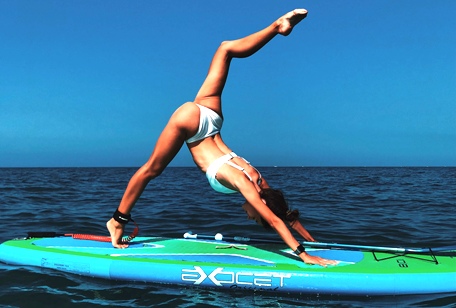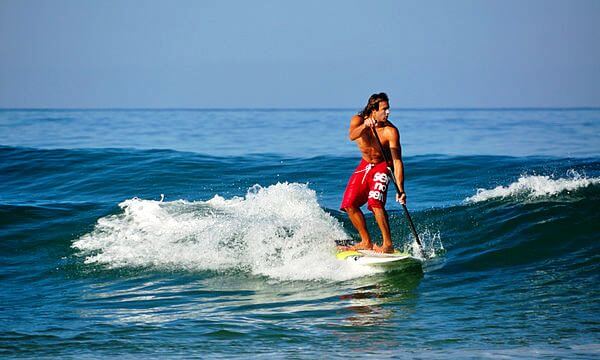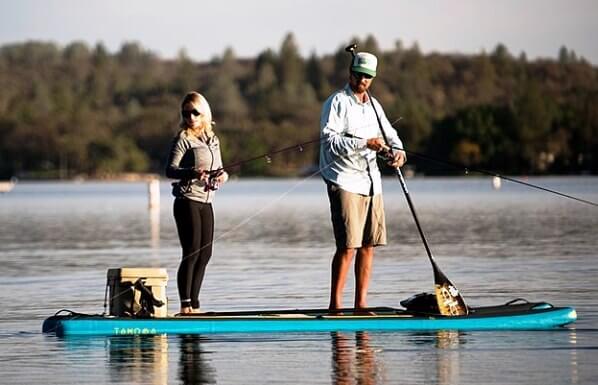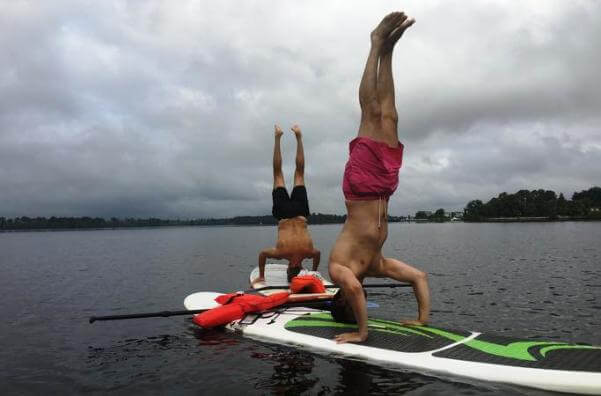How To Balance On A Paddle board: 6 Vital Tips
Knowing how to balance on a paddle board is the one most vital thing that you will ever do. You see, life on the paddle board is a balancing act, literally!
Thankfully, the paddle boards are larger with more volume for a reason – to help you maintain balance.
But first, check: 4 inch or 6 Inch paddle board?
Balancing on the SUP does not start when you are already on the board. It starts after you learn how to get up on a paddle board.
Therefore, in this short post, we shall look at how to get on a paddle board. In addition, we shall also consider how to keep your balance when paddling.
Keep reading!
How To Get On A Paddle Board, Stand and Balance

Getting on a paddle board is harder than getting on a surfboard. Therefore, for a beginner, it will take a few lessons not only to learn how to get up on a paddle board but also where to stand on paddle board.
But first …
1. First, get the right paddle board and paddle
The first and perhaps the most important thing is to make sure that you have the right paddle board and paddle.
If you are of medium height, you should get a medium sized paddle board. If you are really tall, you should get the largest paddle board and paddle in the market. Thankfully, some are even as long as 14 feet.
Also read: Solid vs Inflatable Paddle Boards
However, even if you are small or medium-sized, as a beginner, a larger board will be more appropriate for you.
Keeping your balance on a narrow or smaller board is quite hard. That is why you should start with a larger board and when you have gained some skill, perhaps you can try narrow ones. They will be more challenging.
2. Learning how to get up stand up paddle board for beginners
This will involve some work, including kneeling on the board, erecting and so on. However, if you can launch your board from shallow waters, perhaps you can be able to get up on the paddle board while standing.
But that is not always possible.
First, you need to know where to stand on the paddle board and this should be in the middle. If you stand too close to the nose, it will dip in water.

On the other hand, if you stand too far back, the tail will duck into the water. Therefore, it has got to be right on the middle.
You will have to start with kneeling paddle board style and then you can stand up soon after.
Even before you get to the kneeling position, you will have to straddle the board. Wait a little for the water to settle and then heave yourself to your knees on the board.
After that, you can stand up on your feet. Of course, the paddle will help you stay stable. However, if you find that you do not have proper balance when you are kneeling, you will struggle to stand.
Therefore, you might have to do some kneeling paddle board practice before you can stand.
3. Standing up on the paddle board
Once you have mastered the art of kneeling on the paddle board, it is time to try the bigger challenge of standing on the board.
We suggest that you do all this kneeling and standing on the paddle board thing close to the shore. Sure as the sun is in the sky, there will be falling and rising! That is why you need to practice on still water closer to the shore.
To stand up on the board, the idea is to get your feet where your knees were and that is right in the middle of the board.
Once your feet are where the knees were, it is time to stand up. Do it swiftly unless you have stiff knees.
It is also better to let the water settle some before you can stand up fully. It is also better not to look at the water while standing up.
4. How to balance on a paddle board while standing
Getting up on paddle board is easy. However, when you have known how to do that fluidly, balancing on the board while standing up will be easier.
There are a few important things to note regarding how to balance on the board.
First, you need to keep your feet parallel on the board, right where your knees were in the middle of the board.
Secondly, keep your feet shoulder-width apart. Therefore, if you have a narrower board, you might find it harder to do this.
Thirdly, you need to keep your knees slightly bent but at the same time, you have to keep your torso, shoulders and head as steady as possible. Also, keep your body slightly rocked forwards. That will be your rowing/Paddling stance anyway.
If you move your head or shoulders, you could shift your balance. Therefore, you should only move your hips to shift your weight.
5. Rowing and Maintaining Balance
Call it paddling or rowing, but it means the same thing. You have to put your paddle in the water and with your upper body slightly rocked forward, pull yourself towards the paddle.
Therefore, you are not really pulling the paddle towards you as you would a kayak oar.
Also read: What is a character of a Type III life jacket
Now, the faster you can “row”, the better your balance will be. In addition, you should never lift your paddle out of the water. If you do that, you will start to lose your balance.
In addition, the more or the faster you row, the more stable you are going to be in the water.
Of course, paddle board tips for beginners will also tell you that there will be moments when you will get really unstable.
If this happens, you just need to get lower and paddle more. To reiterate what we have already said, the more you row, the more stable you are going to be.
6. Maintaining Paddle Board Balance with Waves and Boat Wakes

When you are out there in the open water, you are going to meet other traffic. If you are not keen, a boat wake can knock you off your paddle board.
But you did not go through all that hustle of learning how to get on a paddle board just so a boat wake can fell you and make you look like a jerk.
Therefore, learn to paddle board in all manner of conditions. First, do not steer towards the boat wake. Maintain your course. You see, the paddle board is designed to be able to take any side waves.
Of course, the mantra for paddle boarding for beginners is “keep paddling even when in doubt.” Therefore, unless you are taking a siesta in the water, keep paddling.
If there are wind waves, ride them out. This is why your paddle board has a rocker to help it glide over rather than cut through the waves.
Conclusion
That is it for how to balance on a paddle board. It will be hard at the beginning. However, as you get more used to it, your motions will become more fluid.
Like every other trade, knowing how to stand up on paddle board, paddle like a pro and maintain your balance requires you to practice. Therefore, do it as often as you can.
Another of the vital stand up paddle board tips for beginners to bear in mind is … keep to the still waters, close to the shore when you are learning.

